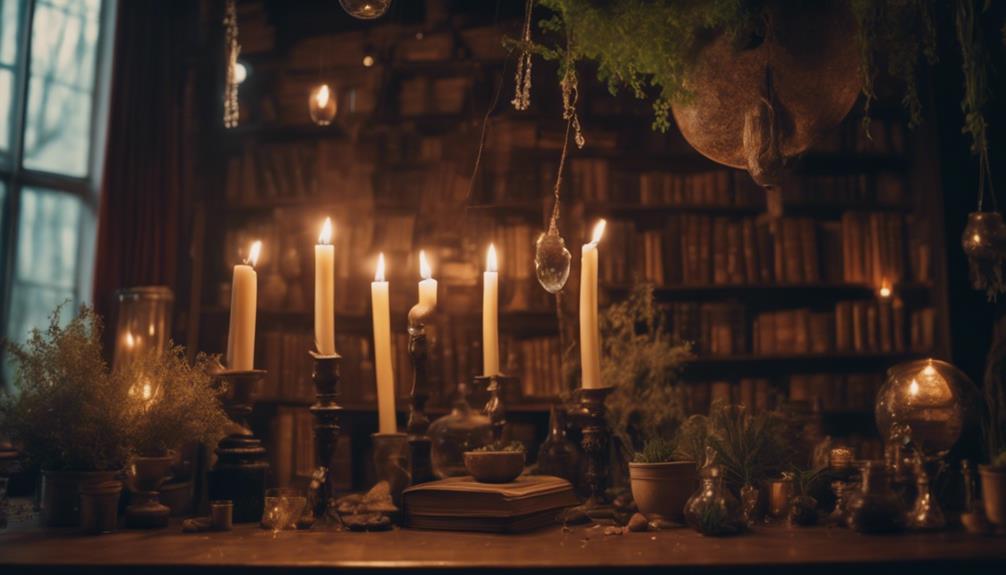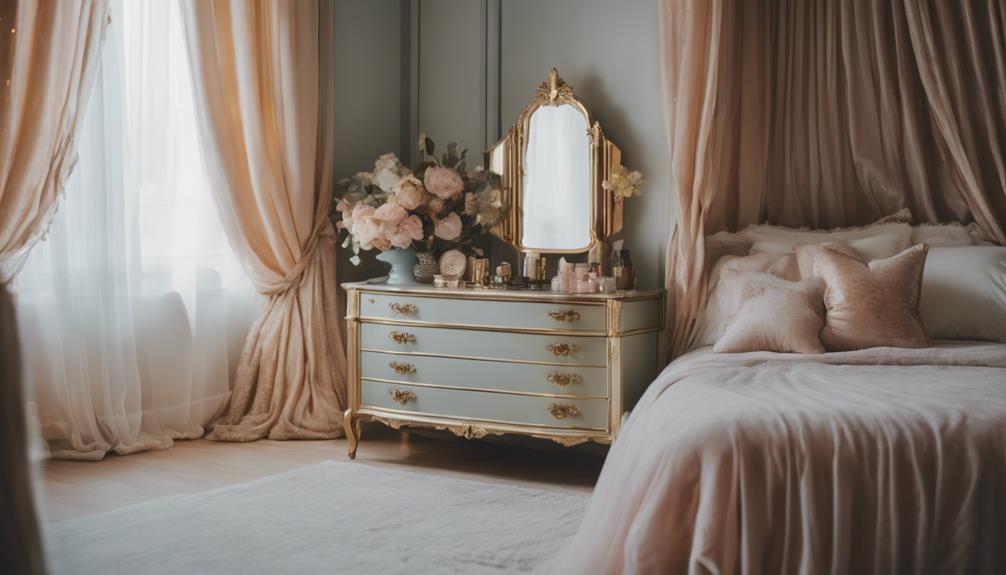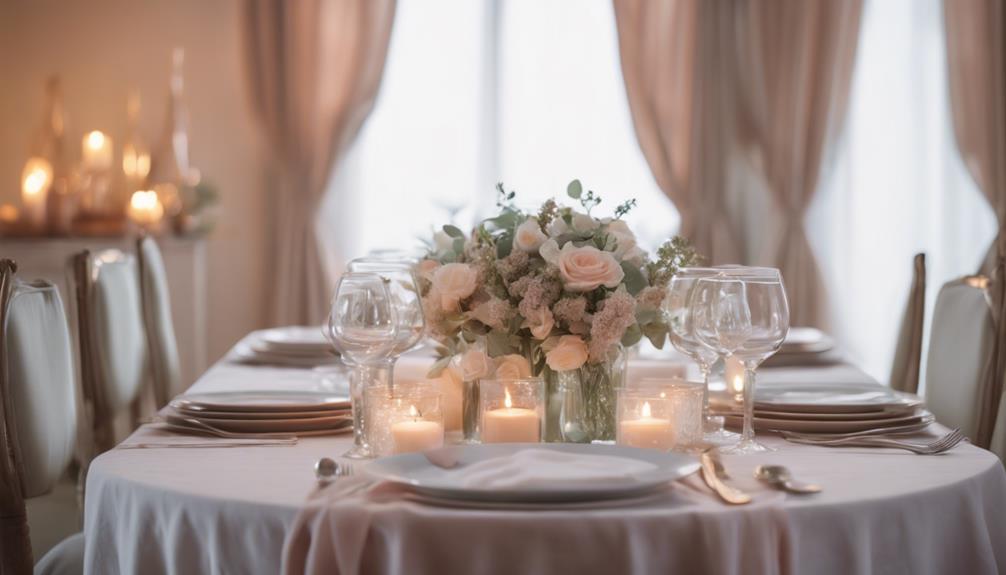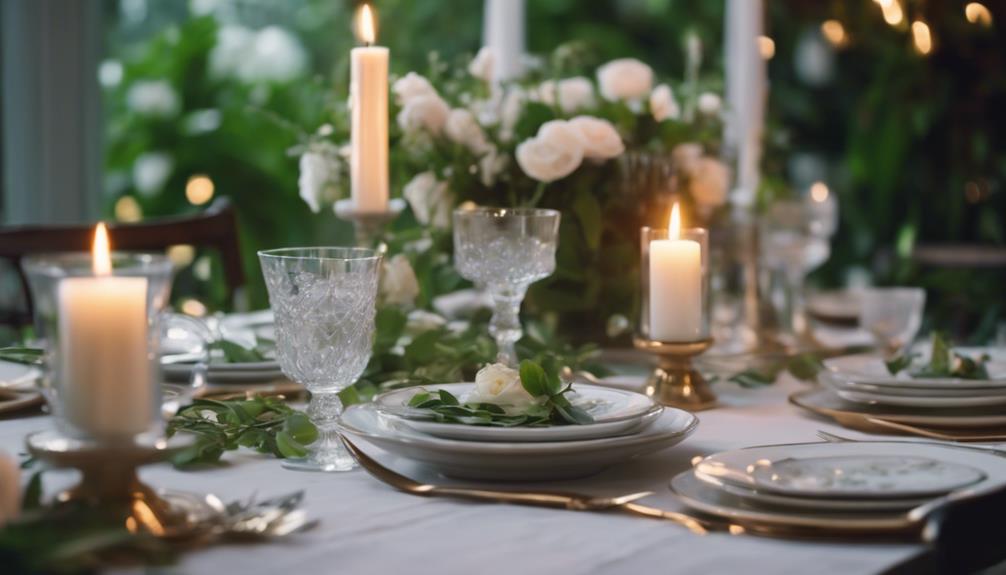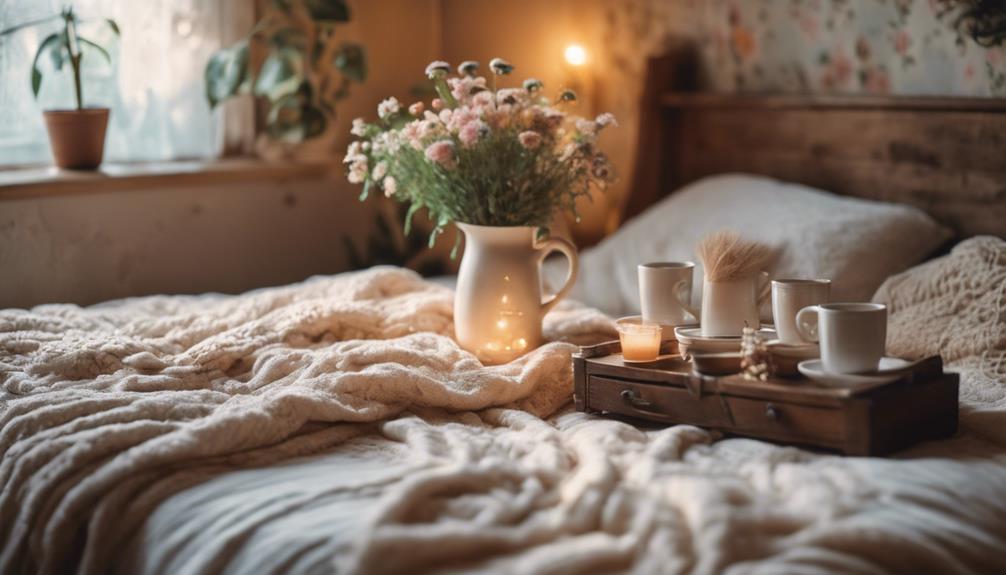You can easily transform your space into a magical retreat with witchcore room decor. Start by using dark greens and earthy tones to create a moody atmosphere. Incorporate vintage furniture and natural materials for a cozy vibe. Don't forget to add cozy textures like velvet throws and hanging plants. Amethyst crystals and celestial art pieces make stunning focal points that enhance the mystical feel. For lighting, try amethyst pendant lights or starry string lights to mimic a night sky. With these enchanting ideas, your room will radiate charm and magic. There's so much more to explore!
Key Elements
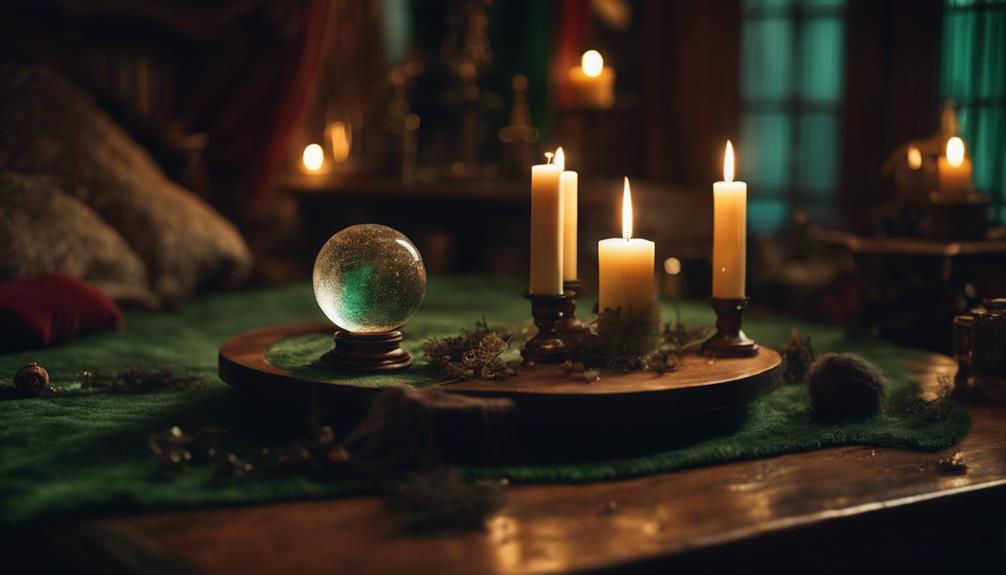
When creating your witchcore space, you'll want to focus on a color scheme that includes dark greens and earthy tones to set the mood.
Pay attention to materials and textures, like velvet and natural fibers, to enhance the cozy vibe.
Mixing these elements will help you achieve that enchanting atmosphere you're aiming for.
Color Scheme
Embracing a color scheme rich in dark greens and earthy tones sets the foundation for a witchcore aesthetic, creating a moody, nature-inspired atmosphere in your room. To achieve this witchy aesthetic, focus on deep shades of green that evoke the feeling of a lush forest. Combine these with earthy browns and muted neutrals, offering a grounding effect that complements the darker hues.
Accents of purple and black can deepen the ambiance, adding layers of mystery and elegance. Consider incorporating soft pastels as contrasting elements; they can lighten the overall feel without overpowering the witchcore vibe. Popular combinations like dark purple with emerald green enhance the richness of the space while maintaining harmony.
Don't forget to introduce subtle metallics for a magical sparkle, elevating the mystique of your decor. These elements can be reflected in decorative items or even wall art, drawing the eye and adding depth.
The right color scheme is essential in crafting a witchcore room that feels both enchanting and inviting, allowing you to immerse yourself in a mystical retreat.
Materials
To truly capture the witchcore aesthetic, focus on incorporating natural materials and unique textiles that enhance the room's mystical vibe. Start by bringing in hanging plants and potted greenery; they help connect your space to nature, which is essential for a witchy room. Opt for vintage or thrifted furniture with rustic finishes to promote a cozy, inviting atmosphere.
When it comes to textiles, choose dark bedding and plush velvet throw blankets in deep hues like purple. These materials create that moody ambiance you're aiming for. Decorative accessories are key, too. Crystals can serve as stunning focal points, adding both beauty and energy to your space.
Consider including wax candles and skull figurines for that extra touch of mystique. Tapestries featuring tarot cards, zodiac signs, and witchcraft themes are perfect for infusing your walls with visual interest. They align well with the overall theme and can make a bold statement.
Textures
Textures play an essential role in enhancing the witchcore aesthetic, inviting you to explore a blend of rich fabrics and natural elements that create an enchanting atmosphere.
Start by incorporating velvet throw blankets in deep colors like purple to add a touch of luxury and warmth to your witch aesthetic room. The softness of velvet contrasts beautifully with other textures, making it a perfect choice for your decor.
Next, consider using natural textures such as wooden furniture and woven baskets. These elements help establish a rustic and earthy ambiance that resonates with the connection to nature found in witchcore design.
To further enhance this organic feel, incorporate hanging plants and potted greenery, which bring life and vibrancy to the space, essential for creating a mystical atmosphere.
Don't forget to display a variety of crystals, such as quartz and amethyst. They not only serve as stunning decor but also bring magical energies and healing properties into your room.
Finally, balance the moody atmosphere with soft pastels, adding a whimsical charm that complements the darker hues in your witch aesthetic room.
Embrace these textures to create a truly enchanting environment.
Essential Fixtures and Furniture
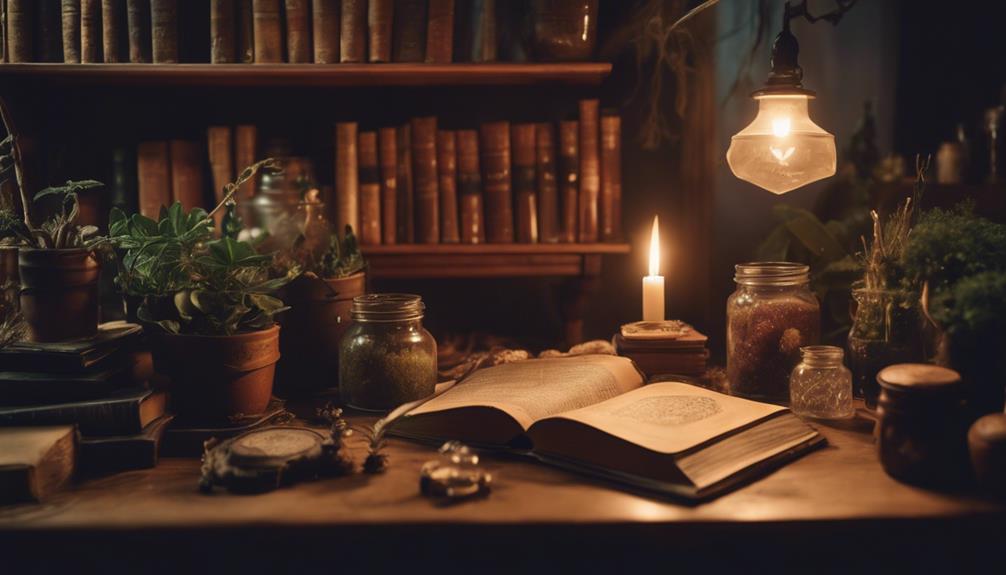
To truly embrace the witchcore aesthetic, focus on essential fixtures and furniture that enhance your space.
An amethyst irregular hexagon crystal can serve as a stunning centerpiece, while a tarot wheel coffee table adds a unique flair.
Don't forget a moon phase bookshelf to showcase your mystical collection and keep the vibe alive.
Amethyst Irregular Hexagon Crystal
Often admired for its unique hexagonal shape, the Amethyst Irregular Hexagon Crystal serves as an enchanting fixture that enhances the mystical vibe of your witchcore room decor. This polished natural crystal not only elevates the aesthetic appeal of your witch room but also promotes a serene and calming atmosphere. Priced from $8.99, it's an affordable addition that fits perfectly on wall shelves or study desks.
What sets this crystal apart is its irregular hexagonal form, making it a standout piece in any collection of witchcore elements. Beyond its visual charm, amethyst is believed to enhance intuition and spiritual awareness, aligning seamlessly with the witchcore focus on connecting to the supernatural. By incorporating this crystal into your decor, you invite a deeper sense of spirituality into your space.
As the trend towards natural materials in home decor grows, the Amethyst Irregular Hexagon Crystal exemplifies a preference for sustainable and meaningful decorative items. Its unique qualities not only serve as a stunning focal point but also resonate with the deeper themes of witchcore aesthetics.
Add this crystal to your witch room, and experience its enchanting presence firsthand.
Tarot Wheel Coffee Table
A Tarot Wheel Coffee Table not only serves as a striking centerpiece in your witchcore room but also brings an air of mystique and conversation around the art of divination. This unique piece combines functionality with a mesmerizing aesthetic, making it a must-have for any witchcore enthusiast.
The intricate tarot card motifs often featured in the design enhance the magical atmosphere, inviting guests to engage in discussions about tarot and spirituality.
You can find these tables crafted from various materials, such as wood and glass, which allows you to customize it to fit your specific decor style. A glass top is particularly enchanting, as it lets you showcase crystals or tarot cards beneath, seamlessly blending your decor with spiritual elements.
Prices for a Tarot Wheel Coffee Table can vary widely, starting from around BZ$100.00, depending on the craftsmanship and materials used. By incorporating this stunning piece into your space, you'll not only elevate the aesthetics of your witchcore room but also create a focal point that encourages exploration and appreciation of the mystical arts.
Moon Phase Bookshelf
Embodying the enchanting essence of witchcore, the Moon Phase Bookshelf not only serves as a striking centerpiece but also provides a practical space for your cherished grimoires and mystical treasures. This unique bookshelf often features celestial designs that resonate with the witchcore aesthetic, instantly drawing the eye and sparking curiosity.
Crafted from vintage or thrifted wood, the moon phase bookshelf enhances the rustic and mystical vibe that characterizes your room. It offers ample space for displaying your essential grimoires, potion-making accessories, and crystal collections, making it an integral part of your witchcore decor.
Incorporate dark shades of green or black into your bookshelf design to align with the moody color palette commonly used in witchcore spaces. You can further elevate the ambiance by adorning the shelves with mystical decor items, such as candles, dried flowers, and tarot card displays.
Lighting Ideas
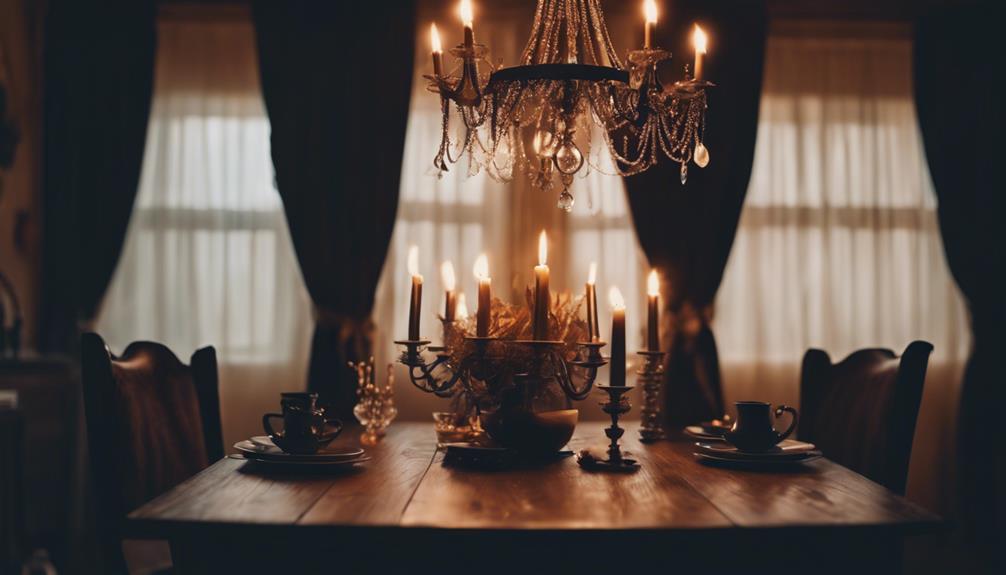
When it comes to lighting in your witchcore room, you'll want to choose pieces that enhance the mystical vibe.
Amethyst crystal pendant lights and crescent moon wall sconces can add an ethereal glow, while starry night string lights bring a touch of magic.
Don't forget a crystal orb table lamp to complete the enchanting atmosphere and provide functional illumination.
Amethyst Crystal Pendant Lights
Amethyst crystal pendant lights transform your space with their enchanting designs and soothing purple glow, perfectly complementing the witchcore aesthetic. These stunning lights not only illuminate your room but also add a touch of mystical elegance that aligns with natural elements and symbolism found in witchcore decor.
With unique designs showcasing the natural beauty of amethyst, these pendant lights enhance both the lighting and overall decor of your space. The calming purple hue promotes tranquility and spiritual energy, essential for creating a serene environment that encourages relaxation and introspection.
Amethyst crystal pendant lights come in various styles, from vintage to modern, allowing you to find the perfect match for your witchcore theme. Whether you prefer intricate, bohemian designs or sleek, contemporary looks, there's an option that will seamlessly integrate into your decor.
Incorporating these lights into your home not only elevates the aesthetic but also serves as a mesmerizing focal point. As both functional lighting and eye-catching decor pieces, amethyst crystal pendant lights draw attention and invite a magical ambiance into your sacred space.
Embrace the allure of these lights and let your witchcore dreams shine!
Crescent Moon Wall Sconces
Crescent moon wall sconces infuse your space with a celestial charm, casting soft light that enhances the witchcore aesthetic beautifully. These enchanting fixtures are a popular choice for those looking to create a mystical atmosphere in their rooms. Often featuring gold or silver metallic finishes, crescent moon wall sconces add a magical sparkle, perfectly complementing darker color palettes.
You can easily pair these sconces with other witchcore elements, like crystals and dark bedding, to create a cohesive and inviting aesthetic throughout your space. Many designs evoke vintage or antique styles, aligning with the witchcore emphasis on unique, thrifted furniture that tells a story.
What's great is that crescent moon wall sconces are available in various price ranges, making them accessible for different budgets, with prices starting from around BZ$27.00. Whether you opt for a minimalist design or something more ornate, these sconces serve as both functional lighting and mesmerizing decor.
Illuminate your room with crescent moon wall sconces and embrace the enchanting vibe they bring to your witchcore sanctuary.
Starry Night String Lights
How can you transform your space into a celestial haven?
Starry Night String Lights bring a soft, twinkling glow that mimics the enchanting night sky, perfectly enhancing the witchcore aesthetic. These lights create a magical atmosphere, illuminating your room decor with a gentle sparkle that feels both cozy and mystical.
Available in charming designs like stars and moons, Starry Night String Lights align seamlessly with the themes of witchcore. You can drape them over furniture, hang them along walls, or outline shelves, making them versatile for any layout.
Their affordability—starting from just BZ$27.00—makes it easy to incorporate this enchanting lighting into your home without breaking the bank.
Crystal Orb Table Lamp
If you love the twinkling ambiance of Starry Night String Lights, the Crystal Orb Table Lamp offers a mesmerizing alternative that enhances the witchcore vibe with its mystical glow and enchanting patterns.
This lamp features a beautifully crafted orb that diffuses light, casting whimsical shapes across your walls and ceiling. Placing it on your crystal desk adds an ethereal touch, making your workspace feel both magical and serene.
You can find a variety of styles, often designed with natural crystal bases, which perfectly align with your aesthetic. Prices typically range from BZ$30.00 to BZ$100.00, depending on the craftsmanship and materials used.
The soft glow emitted by the lamp creates an eerie yet cozy atmosphere, ideal for witchy rituals or simply unwinding after a long day.
Many Crystal Orb Table Lamps also come with adjustable brightness settings, allowing you to tailor the lighting to suit any occasion—be it a calm evening of divination or a spirited gathering with friends.
Incorporating one of these beautiful lamps into your decor not only elevates your space but also invites in a sense of tranquility and wonder.
Decorative Elements
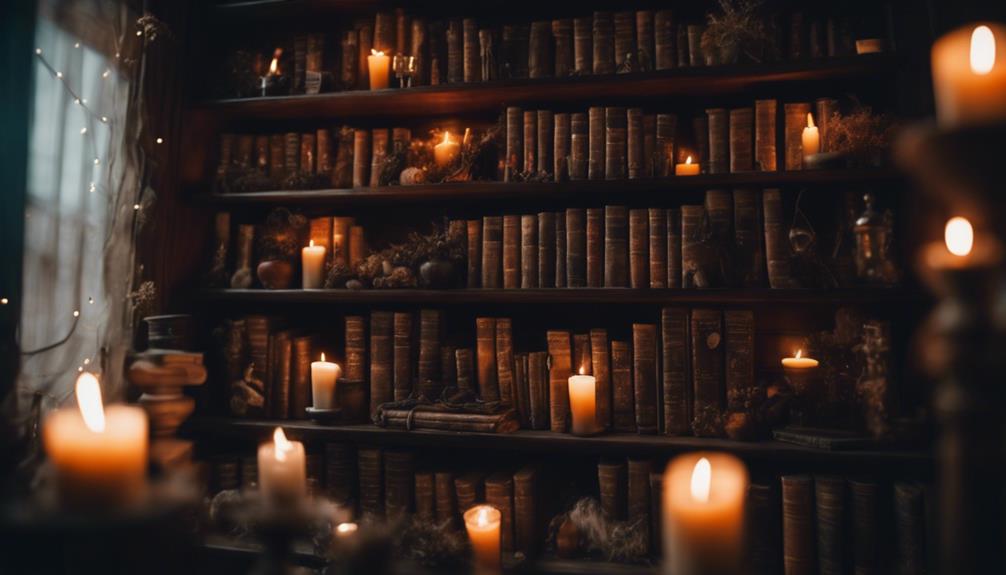
When you're curating your witchcore space, consider adding striking decorative elements like an amethyst crystal geode accent piece.
Celestial star wall hangings and moon phase wall art can also bring a mystical touch to your walls, enhancing the overall vibe.
These pieces not only look great but also resonate with the themes of magic and nature that define the witchcore aesthetic.
Amethyst Crystal Geode Accent Piece
The Amethyst Crystal Geode Accent Piece brings an enchanting touch to your Witchcore decor, showcasing its rich purple hues and unique formations that enhance your room's mystical ambiance.
These stunning decorative elements not only serve as eye-catching focal points but also align perfectly with the themes of spirituality and nature found in the Witchcore aesthetic.
Amethyst is known for its calming energy, believed to promote relaxation and mental clarity, making it a fantastic addition to your personal space.
You can find these accent pieces in various sizes, allowing you to place them on shelves, desks, or as striking centerpieces. No matter where you choose to display your amethyst crystal geode accent piece, it'll add a touch of elegance and intrigue to your decor.
With prices starting around $21.99, amethyst geodes are an accessible choice for anyone looking to elevate their Witchcore room.
Incorporating one of these beautiful pieces into your space not only enhances the visual appeal but also infuses your environment with a sense of tranquility and connection to the mystical world.
Let the enchanting charm of amethyst transform your room into a serene sanctuary.
Celestial Star Wall Hanging
A celestial star wall hanging enhances your Witchcore aesthetic by adding a mystical touch that captures the beauty of the cosmos.
These stunning pieces often feature intricate designs that evoke a sense of wonder and connection to the universe. Whether you choose one made from fabric, metal, or wood, a celestial star wall hanging offers versatile styling options that perfectly complement dark and earthy color schemes.
You'll find that many of these hangings incorporate motifs like moons, constellations, and astrological symbols, enriching the overall witchy vibe of your space. By pairing your celestial star wall hanging with soft lighting—like string lights—you can create an enchanting atmosphere that highlights the celestial theme and invites a sense of tranquility.
Moreover, prices for celestial star wall hangings typically range from $20 to $60, making them an accessible decorative element for anyone looking to elevate their Witchcore decor.
Celestial Moon Phase Wall Art
Celestial moon phase wall art brings an enthralling energy to your space, celebrating the beauty of nature and the supernatural with intricate designs that illustrate each phase of the moon. This decorative element is a staple in witchcore aesthetics, creating a connection to lunar cycles and the mystical forces they represent.
You can find celestial moon phase wall art made from various materials, like canvas, wood, or metal, catering to different budgets with prices ranging from approximately BZ$14.99 to BZ$141.00. When you incorporate this art, it not only enhances the room's ambiance but also serves as an enthralling focal point that pairs perfectly with other witchcore decor like crystals and candles.
Many designs feature additional celestial motifs, such as stars and constellations, enriching your decor theme and creating a cohesive aesthetic. To maximize its enthralling effect, hang these artworks in well-lit areas or above cozy seating.
Soft lighting or fairy lights can elevate the magical appeal, making your room feel even more inviting and mystical. Embrace the celestial moon phase wall art, and watch your space transform into a haven of beauty and wonder.
Flooring
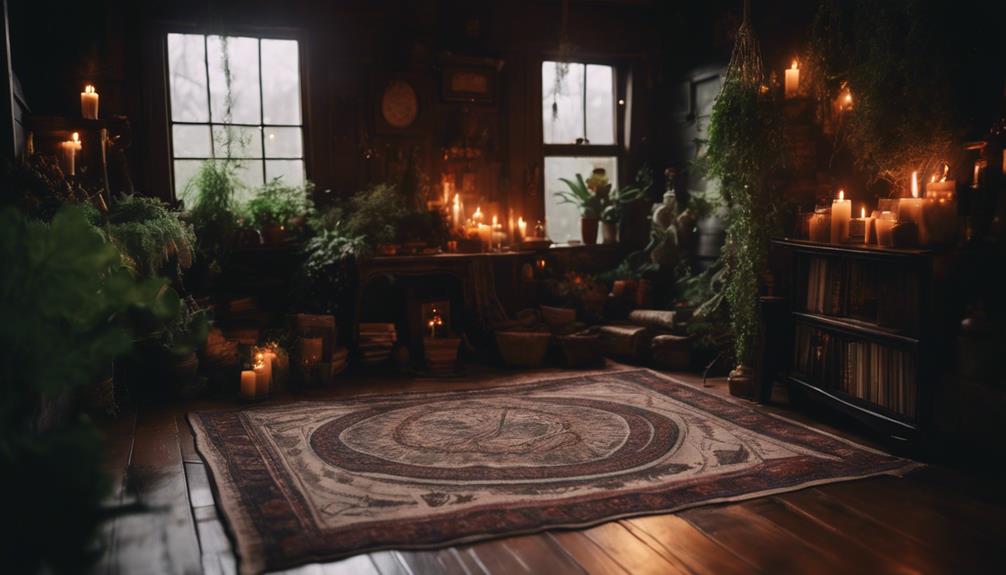
When it comes to flooring for your witchcore space, think about incorporating dark wood with silver accents for a touch of elegance.
A moon phase patterned area rug can add a mystical vibe, while black and white checkerboard tiles inject a bit of whimsy and contrast.
Each of these choices helps create a cohesive atmosphere that enhances the witchcore aesthetic.
Dark Wood With Silver Accents
Dark wood flooring sets a rich, moody foundation that perfectly complements silver accents, creating an enthralling atmosphere for your witchcore space. The deep tones of dark wood enhance the overall mystical vibe, grounding your decor in a sense of elegance and depth. When you add silver accents—like metallic furniture or decorative pieces—you create a striking contrast that elevates the aesthetic, infusing a touch of magic into your environment.
This combination evokes a sense of timelessness, reminiscent of ancient rituals and gatherings. To maintain a cohesive look, choose silver elements that harmonize with the dark wood, ensuring they enhance rather than overwhelm the space. Incorporating small touches, such as silver candlesticks or framed mystical art, can further enrich your decor.
While you might consider adding area rugs with witchy motifs later, the interplay of dark wood and silver already sets an enthralling stage. It's important to balance these elements to foster a harmonious ambiance that aligns perfectly with witchcore themes.
Moon Phase Patterned Area Rug
A moon phase patterned area rug instantly brings a touch of enchantment to your witchcore decor, enhancing the room's mystical vibe. These rugs feature intricate designs that beautifully depict various moon phases, making them an ideal choice for astrology enthusiasts.
When you place a moon phase patterned area rug in your space, it serves as a stunning statement piece, whether in a cozy seating area or as a grounding element in larger rooms. You'll find these rugs in various sizes, so you can choose one that perfectly fits your needs. Made from soft, durable materials, the moon phase patterned area rug guarantees both comfort and longevity, complementing other elements of your witchcore decor.
Imagine sinking your feet into a plush rug while enjoying the magical atmosphere of your room. To enhance the celestial theme, consider pairing your moon phase rug with other decor items like wall hangings or bedding adorned with stars and moons.
This cohesive look creates an enchanting atmosphere that invites creativity and inspiration. With a moon phase patterned area rug, your space becomes a beautiful sanctuary, reflecting your mystical style.
Black and White Checkerboard Tiles
Black and white checkerboard tiles instantly elevate your witchcore space, adding a bold visual contrast that enhances the overall mystical atmosphere. These striking tiles can transform your flooring or even your walls, creating a geometric element that draws the eye and complements the dark, moody color schemes typical of witchcore aesthetics.
By incorporating black and white checkerboard tiles, you evoke a sense of vintage charm that aligns perfectly with the thrifted and antique furniture often found in witchcore interiors. This classic design balances out other dark decor elements, such as velvet throws and deep-toned bedding, while still maintaining an enchanted vibe.
Pairing these tiles with natural elements like potted plants or crystal decor creates a unique juxtaposition, enriching your overall witchcore aesthetic. The contrast of the tiles against lush greenery or shimmering crystals adds depth and intrigue to your space.
How Can I Incorporate Witchcore Room Decor Ideas Into an Ethereal Room Transformation?
Transform your space with witchcore room decor ideas that will bring an otherworldly atmosphere to your room. Incorporate ethereal room decor transformation techniques, such as using dreamy fabrics, mystical symbols, and enchanting lighting to create a magical and mystical ambiance. Embrace the magic of witchcore and elevate your space to new heights.
Conclusion
By incorporating these witchcore room decor ideas, you can create a mystical and aesthetic space that truly reflects your personality.
Focus on key elements like essential fixtures, unique lighting, and enchanting decorative pieces to bring your vision to life.
Don't forget about the flooring, as it can set the tone for the entire room.
Embrace your creativity, and let your inner witch shine through in every detail of your cozy sanctuary!
